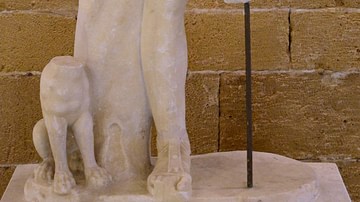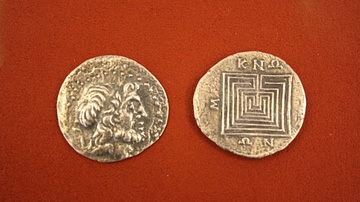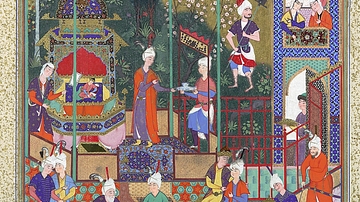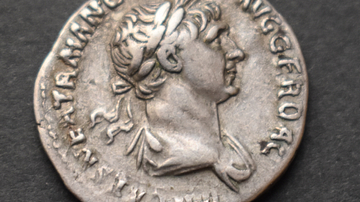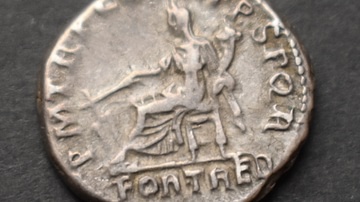Illustration
Silver coin from the Roman Crete, 97-117 CE.
The British Museum, London.
After the Roman conquest of Crete in 66 BCE, emperors sympathetic to Greek culture, such as Trajan and Hadrian, focused on renovating and developing public spaces, especially Greek temples, across the island. One of the most popular sites was the sanctuary of Britomartis/Diktynna, known as the Diktynnaion, located near modern-day Khania (Chania) on the northwest coast. The cult of Diktynna, a goddess associated with hunting and fishing nets, was closely linked to Artemis and supposedly widespread locally and beyond. Although earlier Greek writers described her as a nymph or a young virgin who was immortalized by Artemis, later sources developed a divine genealogy for her, reflecting her growing popularity. During the Hellenistic period, she was portrayed as the daughter of Zeus and Karme, the Cretan granddaughter of Demeter, and later as the third child of Zeus and Leda, making her a sibling of Artemis and Apollo. In the Roman Empire, Diktynna was worshipped as a great mother goddess in Crete and Aegina and was increasingly viewed as the mother or nurse of Zeus, as shown on the silver coin depicted here.
Cite This Work
APA Style
Museum, T. T. o. t. B. (2025, January 07). Trajan Cretan Silver Coin Showing Diktynna and Infant Zeus. World History Encyclopedia. Retrieved from https://www.worldhistory.org/image/19836/trajan-cretan-silver-coin-showing-diktynna-and-inf/
Chicago Style
Museum, The Trustees of the British. "Trajan Cretan Silver Coin Showing Diktynna and Infant Zeus." World History Encyclopedia. Last modified January 07, 2025. https://www.worldhistory.org/image/19836/trajan-cretan-silver-coin-showing-diktynna-and-inf/.
MLA Style
Museum, The Trustees of the British. "Trajan Cretan Silver Coin Showing Diktynna and Infant Zeus." World History Encyclopedia. World History Encyclopedia, 07 Jan 2025, https://www.worldhistory.org/image/19836/trajan-cretan-silver-coin-showing-diktynna-and-inf/. Web. 17 Apr 2025.

